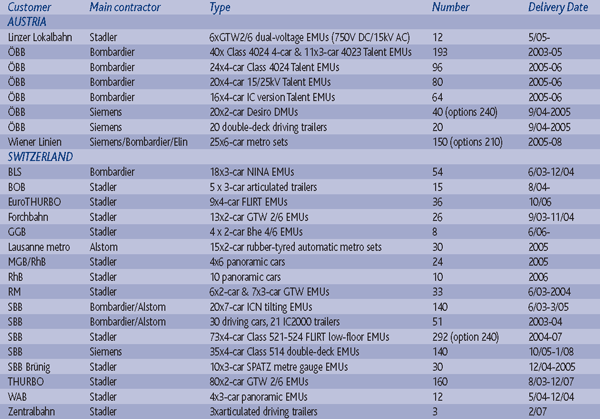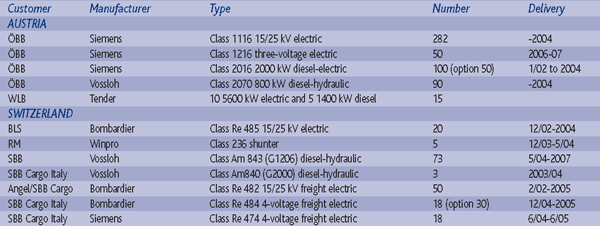Alpine stream of rolling stock orders
Posted: 31 May 2005 | | No comments yet
Switzerland and Austria are investing heavily in new locomotives for trans-Alpine freight work, along with regional trains for local passenger networks.
Switzerland and Austria are investing heavily in new locomotives for trans-Alpine freight work, along with regional trains for local passenger networks.
Switzerland and Austria are investing heavily in new locomotives for trans-Alpine freight work, along with regional trains for local passenger networks.
Switzerland’s railways have benefited in past years from a pro-rail political consensus that has allowed heavy investment in the network. The latest fruit of this policy was the opening of the Mattstetten-Rothrist cut-off line in December last year, which allowed implementation of the Bahn 2000 timetable with its standard-interval pattern and enhanced end-to-end journey times. Work is proceeding on the Simplon and Gotthard base tunnels under the Alps, which will boost capacity on these routes.
Rail patronage in the country reflects the excellent standard of service that steady investment has made possible. The average Swiss citizen makes 40 train journeys each year, more than any other country in Europe (the figure for the next in the league, Denmark, is 28).
Investment in rolling stock has proceeded to complement that in infrastructure. Mainstay of the Swiss inter-city fleet is the fleet of ICN tilting EMUs built by Bombardier and Alstom, deliveries of which were drawing to a close in the spring of 2005. The inter-city fleet has also been supplemented recently by 21 IC-2000 second-class cars, which again have been built by a consortium of Bombardier and Alstom.
These two companies have traditionally been strong in Switzerland. Bombardier inherited the assets of the former national champion Brown-Boveri through acquisition, while Alstom’s purchase of Fiat brought with it the former SIG bogie factory at Neuhausen.
Nowadays, competitive tendering puts the multinationals on a level playing field. Two years ago the German builder Siemens achieved a breakthrough in Switzerland with an order for EMUs for the Zurich S-Bahn. The terms of train manufacture and delivery agreed by SBB and Siemens Schweiz AG call for considerable local content from Switzerland. The four-car double-deck trains will offer end-to-end walk-through accessibility and, with 396 seats and standing room for 600, will be able to accommodate around 1,000 passengers. These trains will have a top speed of 140km/h, will be fully air-conditioned and equipped with vacuum toilet systems.
A new national champion is emerging in the shape of Stadler. Swiss-owned, with factories in Altenrhein and Bussnang, Stadler now employs more than 1050 personnel – this compares with just 20 in 1990! The group’s products include the GTW articulated railcar, the Regio Shuttle RS1, and the Fast Light Innovative Regional Train, FLIRT.
Stadler has built a strong presence in its chosen niche of local trains, scoring with both Swiss Federal Railways (SBB) and local railways (see Table 1). In January 2005, SBB ordered another 31 four-carriage FLIRTs from Stadler Bussnang AG, drawing down on an option established in 2002 when 42 trains were ordered for Stadtbahn Zug and the Regio-S-Bahn Basel. The 31 FLIRTs will operate as dual-system vehicles on the Ticino/Lombardy (TILO) rail network in 2007 and on the S-Bahn Basel network in Alsace (Mulhouse) in 2008. The value of this order amounts to approximately SFR279 million.
Stadler already owns a German subsidiary, Stadler Pankow GmbH in Berlin, and is now seeking to expand abroad. The Berlin factory benefited from stipulations set by the European Commission when Bombardier acquired Adtranz, at which time Brussels was keen to establish Stadler on a firm footing in order to maintain competition in the marketplace. Stadler is now planning a Polish factory to complement the one in Berlin and has acquired the assets of the bankrupt rolling stock company PFA of Weiden in south-east Germany. The company has sold its GTW 2/6 design in Slovakia.
LRVs for Vienna
Some of the strongest activity in the rolling stock market in Austria recently has been in the urban and short-distance sector, with the local operator in the Austrian capital, Wiener Linien, going on a spending spree.
In December last year, Wiener Linien ordered 38 low-floor light rail vehicles from Bombardier for Vienna Line U6 for delivery between the end of 2006 and mid-2008. These will be similar to 78 vehicles Bombardier delivered for Line U6 from 1993 to 2000, with the important distinction that in the new vehicles passengers will benefit from air conditioning.
The contract for the extra 38 vehicles has a total value of €91 million, with Bombardier’s share estimated at some €69 million. The contract also includes an option for a further 42 LRVs. The vehicles will be built at Bombardier’s production facilities in Vienna, with Vossloh Kiepe assuming responsibility for the electrical equipment.
Another follow-on order from Wiener Linien has been awarded to Siemens Transportation Systems, with its consortium partner Elin EBG – the companies behind Vienna’s innovative ultra-low-floor (ULF) tram design. Siemens was awarded the first order for 150 ULFs in 1997, and so far there are 130 of the design in service. Last summer Wiener Linien ordered a further 150 ULF trams, with an option for another 150. The order (excluding the option) is worth about ?357 million, with Siemens’ share amounting to around €255 million or approximately 70%.
The new ULF series will adhere to the original basic concept: with the world’s lowest entry height of 19 centimetres, maximum door widths, modern traction technology, and Porsche Design. There is a weight reduction with the new tranche, which has been achieved through simplification of the drive design and a changeover from water to air cooling. Like the new U6 cars, the new tranche of ULFs will benefit from air conditioning.
The low entry height on the ULFs is made possible by a design principle using portal running gear instead of conventional bogies. In this case, the wheels are driven individually by electric motors that are arranged not horizontally under the floor plate but vertically behind the sidewall panelling. This traction equipment also enables the recovery of braking energy and reduction of running noise. The wide doors and low step facilitate boarding and exiting by passengers, resulting in an overall time saving of 40 per cent during operation.
The first 25 of the new tranche of ULF trams are to be delivered in 2006, with the rest following by 2012. All the trams will be built at Siemens’ production plant in Vienna. Siemens’ Vienna plant is also building metro trains for Wiener Linien. A contract was agreed in 2002 with a consortium of Siemens, Bombardier and Elin for 25 metro trains to operate on the underground lines U1 to Leopold and U2 to Aspern. The first six-car metro trains within this order were due to be delivered at the beginning of 2005 and all 25 units are due to be in service by the end of 2008. The total value of the order amounts to €192 million, with Siemens’ share about €133 million and the other €59 million going to Bombardier and Elin.
The trains feature a continuous 112 metre long passenger area, which is monitored with CCTV equipment and enables a more uniform distribution of the passengers. Each train will have enough space to transport 900 passengers.
Talents
On the mainline railways in Austria, Bombardier has been successful with its Talent design of multiple-unit. An initial order for 51 trains placed in 2001 by Austrian Federal Railways (ÖBB) was followed up in November 2003 with an additional order for 60 four-car units, some of them with dual-voltage capability.
The vehicles are being built at Bombardier’s site in Aachen, Germany, with Elin EBG Traction supplying part of the electrical equipment from Vienna, Austria. Commissioning of the vehicles is being undertaken at ÖBB’s Technical Services facility in Vienna. The contract for 60 EMUs has a total value of €215 million, with Bombardier’s share accounting for some ?160 million. The 60 trains are scheduled to be delivered between July 2005 and the end of 2006.
Buoyant loco demand
Heavy traffic flows across the Alps between the industrial areas of Germany and northern Italy have led to high demand for locomotives in the Alpine region.
The latest delivery is the Rh 1216, a multivoltage loco in the Siemens Eurosprinter family designed for cross-border working. At the end of March 2005, the first three of 50 Rh 1216 Bo-Bo locomotives were handed over to ÖBB (Austrian Federal Railways). Ordered in 2003, the Rh 1216 is suitable for national and international passenger and freight work. The locomotive has been designed for use on lines with supply voltages of 15kV/16.7Hz, 25kV/50Hz, and 3kV DC, and it has a maximum speed of 230km/h. The locomotive can be operated at reduced power on networks electrified at 1.5kV DC in The Netherlands and the south of France.
The Rh 1216 features water-cooled IGBT inverters and the SIBAS 32 control system. Siemens has recently received an order from the Slovenian State Railway for 20 similar tri-voltage locomotives.
SBB too is building up a fleet of multi-voltage locos for cross-border freight. In February 2005, the first of 18 Class Re 484 Bombardier TRAXX locomotives began revenue-earning service. Designed for both AC and DC systems, the TRAXX locos are being used for freight services between Switzerland (15kV AC) and Italy (3kV DC), particularly on the Bellinzona- Luino-Gallarate route.
The locomotives have a top speed of 140km/h and an output of 5.6MW and feature the Bombardier Mitrac lightweight propulsion system. Design was carried out at Bombardier’s facilities in Oerlikon and Turgi (Switzerland). The locomotives have been built in Kassel and subsequently commissioned in Switzerland by Bombardier.
In February 2005, SBB placed a follow-on order with the German loco manufacturer Vossloh, for 14 Class Am 843 1,500kW diesel-hydraulics. The company already had 59 of these machines on order, with delivery due to be completed this summer. The new tranche will be delivered in 2007.


Table 1: Recent orders for passenger coaching stock in Austria and Switzerland


Table 2: Recent locomotive orders in Austria and Switzerland







